The longevity of your house can be tied to the condition of its roof, as it serves as the primary defense against external elements, ensuring the safety and security of you and your household. This highlights the crucial role of roof maintenance.
With regular maintenance, you can extend your roof's lifespan, providing peace of mind while enhancing the overall value of your property for many years to come.
So, how can you extend its service lifespan and ensure its peak performance? Let's delve into some critical maintenance tips.
- Conduct Regular Inspection
Start maintaining your roofing system with a simple yet vital step – regular inspection. Periodic checks, especially after extreme weather events, can reveal potential problems like loose shingles, cracks, or signs of wear and tear. By detecting issues early, you can prevent a minor problem from turning into a major one, saving significant repair costs.
However, if you think a professional inspection is best, contact them immediately to get the job done without delay.
- Keep Pine Needles Out
Once inspections are done, another thing to watch out for is debris, starting with pine needles. Pine needles might seem harmless in most cases, but they can accumulate and trap moisture against the roof's surface, leading to potential damage. With regular cleaning, you can keep pine needles out of gutters and off the roof to prevent water pooling and subsequent damage.
However, if you need professional gutter protection, working with roofing experts would be invaluable. Given their expertise and skills, you can have peace of mind knowing pine needles will be kept out of your gutters for a long time.
- Clean The Gutters
Besides pine needles, gutters can accumulate leaves, debris, and other obstructions that prevent water from flowing away from the roof. This accumulation of materials can cause gutters to clog, resulting in water backup. Such backups can increase the likelihood of leaks and potentially cause structural damage to the property.
Therefore, find the time to clean the gutters thoroughly. If your gutters are heavily clogged, you may need a cleaning wand or power washer to dislodge the debris. However, if you're using the pressure washer, be careful not to spray water directly on the roof shingles, as this could damage them and lead to leaks.

- Address Moss And Algae
Over time, roofs, especially in damp climates, can be susceptible to moss and algae growth. Besides diminishing the aesthetic appeal of your home, these growths also compromise its structural integrity by holding moisture against the shingles.
That said, consider periodic cleaning with recommended solutions to combat these issues. For instance, use a stiff brush to scrub the moss and algae off the roof. Another approach is to apply a mixture of one part bleach to four parts water to the moss and algae. Let the mixture sit for 15 minutes, then scrub the moss and algae off the roof. Rinse it with water after you're finished.
- Replace Damaged Or Missing Shingles
Weather events or wear and tear can lead to damaged or missing shingles. However, neglecting these issues can be risky, as it exposes the underlying structure to water damage, which could lead to costly repairs in the future.
To mitigate these risks, regularly check your roof for such issues and promptly replace any problematic shingles. To make the process smoother, consider reaching out to a professional roofing company that specializes in shingle replacement. Their expertise will ensure that the replacement is handled efficiently and effectively, giving you peace of mind and protecting your home from further damage.
- Ensure Proper Attic Ventilation
A well-ventilated attic plays a vital role in prolonging the roof's lifespan. Proper ventilation prevents moisture build-up in winter and reduces heat in the summer, which helps ensure the shingles last longer and saves on energy bills.
To maintain proper attic ventilation, it's essential to keep your vents unobstructed. Regularly inspect them for any potential blockages that could hinder airflow, such as insulation, debris, or even accumulations of snow.
- Install Protective Barriers
In regions prone to snow, consider installing snow guards or barriers. These tools can prevent large amounts of snow from sliding off the roof, reducing the risk of damage or injury. They can also help distribute the weight of accumulated snow and reduce the strain on the roof.
- Trim Overhanging Tree Branches
Large trees with branches hanging over the roof might provide shade but pose risks. For one, falling branches can cause direct damage, and overhanging limbs can drop leaves and other debris, leading to gutter blockages. Therefore, regularly trim such branches to maintain a safe distance from the roof and protect it from potential damage.
- Check Sealant And Re-Apply
Sealants are applied to various parts of the roof to prevent water intrusion. But over time, these can wear off or become damaged. Hence, regularly inspect the roof's sealants, especially around vents, chimneys, and skylights, and re-apply when necessary.
- Stay Off the Roof
While regular maintenance is crucial, it's important to avoid causing further damage. Walking on the roof, for example, can cause damage to the shingles and decrease their lifespan. If inspections or cleanings are needed, use proper equipment like roof ladders or hire professionals who are trained to navigate rooftops safely. This way, you can ensure your roof is in good working condition.
Conclusion
By implementing these maintenance tips, you can significantly extend your roof's lifespan, ensuring it remains a protective shield against the elements. Remember, the key to a long-lasting roof isn't just in the installation but in the continuous care and attention it receives thereafter.






